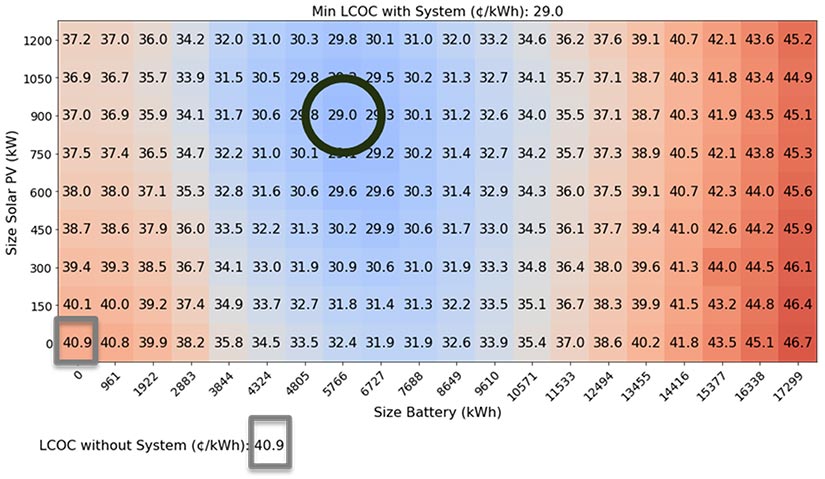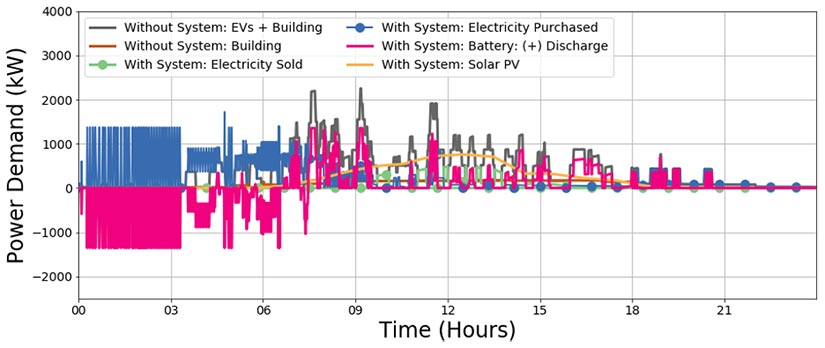EVI-EDGES: Electric Vehicle Infrastructure – Enabling Distributed Generation Energy Storage Model
NREL's EVI-EDGES model configures optimal, cost-effective behind-the-meter-storage (BTMS) and distributed generation systems based on the climate, building type, and utility rate structure of potential electric vehicle (EV) charging sites.
EVI-EDGES helps answer a key question: How can behind-the-meter storage and distributed generation mitigate the costs and grid impacts of vehicle electrification?
As NREL's premier BTMS analysis tool, EVI-EDGES optimizes BTMS system designs to mitigate the costs and grid impacts of fast EV charging through integrated thermal and battery energy storage with on-site solar photovoltaic (PV) generation.
NREL analysts work directly with business and industry partners to meet cost and performance targets for tailored BTMS solutions, focusing on:
- Levelized cost of charging (LCOC)
- Total system energy use and efficiency
- Resiliency and flexibility of the storage system.
Approach and Uses
EVI-EDGES in Action
Electric vehicle charging at retail locations offers convenience, building integration opportunities.
Rapid EV adoption and increased energy demands may strain grid infrastructure and buildings operations. EVI-EDGES offers a solution by streamlining BTMS system designs to make EV charging cost-effective for drivers and profitable for businesses.
During the pre-process stage, researchers generate baseline load profiles for the building and EV charging stations. Then, leveraging NREL's high-performance supercomputing and advanced visualization techniques, EVI-EDGES determines the most cost-effective BTMS design across these parameters:
- Climate – Building energy use, battery conditioning, battery lifetime, efficiency of EVs
- Utility rate structures – Demand and energy charges
- Building type – Energy demand profiles, space limitations, population served
- Capital costs – Stationary batteries, thermal energy storage, electric vehicle charging equipment, PV panels, power electronics
- Controls algorithm – When to dispatch stationary battery and thermal energy storage
- Storage operation – Battery and thermal energy storage state-of-charge, discharge and charge rate, operating temperature.
- Existing connection to the energy grid – Potential costs for needed infrastructure improvement
- Resiliency of the system – Operation during times of power outages.

Example EVI-EDGES results: Impact of the use of BTMS and PV to reduce utility costs and the cost of EV fast charging.

Example EVI-EDGES results: Daily profile of energy flows within the BTMS system, showing how batteries and thermal energy storage are dispatched to reduce utility costs and the cost of EV fast charging.
Integrated Multi-Tool Design
EVI-EDGES interacts with multiple NREL and U.S. Department of Energy (DOE) analysis tools including:
REopt: Renewable Energy Integration and Optimization
EVI-Pro: Electric Vehicle Infrastructure – Projection Tool
EVI-EnSite: Electric Vehicle Infrastructure – Energy Estimation and Site Optimization Tool
Publications
Levelized Cost of Charging of Extreme Fast Charging with Stationary LMO/LTO Batteries, Journal of Energy Storage (2024)
Impact of Electric Vehicle Charging on the Power Demand of Retail Buildings, Applied Energy (2021)
Initiate EVI-EDGES Analysis
There are two options for engaging with NREL to conduct an EVI-EDGES analysis:
Private sector clients can partner with NREL under a technology partnership agreement.
Federal agencies can request technical assistance funding from the Federal Energy Management Program or partner with NREL under an interagency agreement.
Contact
Share
Last Updated April 4, 2025

